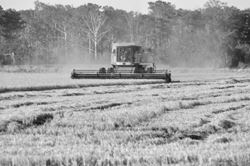Second-Crop Rice Harvest Called ‘Outstanding’
CROWLEY, LA.
LSU AgCenter rice specialist Johnny Saichuk said this year’s second rice crop in south Louisiana was outstanding.
“Based on all the reports, it seems to be a record second crop yield,” he said.

A combine harvests second-crop rice at the Live Oak Farm in Vermilion Parish. Many farmers had excellent second crop harvests in 2014.
Photo by Bruce Schultz
No records are kept for second crop yields, but Saichuk said it was not uncommon to hear of farmers cutting 20-30 barrels an acre. Years ago they only managed 5-10 barrels. Each barrel equals 162 pounds of rice.
Mild fall weather with good sunshine helped rice regrow after the first harvest. Even medium-grain varieties, which typically are not high-yielding for second crop rice, had good results, he said.
Farmers are treating the ratoon crop as an important part of their growing season. “You hear more people making a commitment to do things on time,” Saichuk said. “A lot of people realize they need the volume to make money.”
Heavy rains after the first harvest meant farmers didn’t have to pump as much water for the second crop.
Steve Linscombe, director of the LSU AgCenter Rice Research Station, said some farmers had their best second crop ever.
With a good first crop and an excellent second crop, Louisiana’s overall harvest is close to last year’s record crop, he said.
Some farmers simply closed their levees and took advantage of rain, with minimal pumping and no fertilizer after the first harvest. “They still made decent yields under those unique conditions,” Linscombe said.
This year’s fall cold snap delayed crop development, and some farmers have not completed their harvest.
Farmers have treated the ratoon crop as a bonus in years past, Linscombe said, but many are starting to manage the second crop better.
“I think our producers these days understand that if they manage the second crop as well as the first crop, they’ll see the dividends,” he said.
More farmers are starting to roll or clip the rice stubble after the first harvest to get a better second crop. Research at the Rice Research Station has shown the value of that practice, Linscombe said.
But a second crop will remain risky because of the chance of an early fall frost, or a late season hurricane, he said.
Blackbirds also were a problem for the second crop in some areas because the rice was slow to develop. ∆